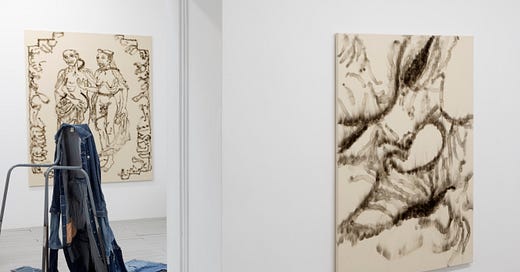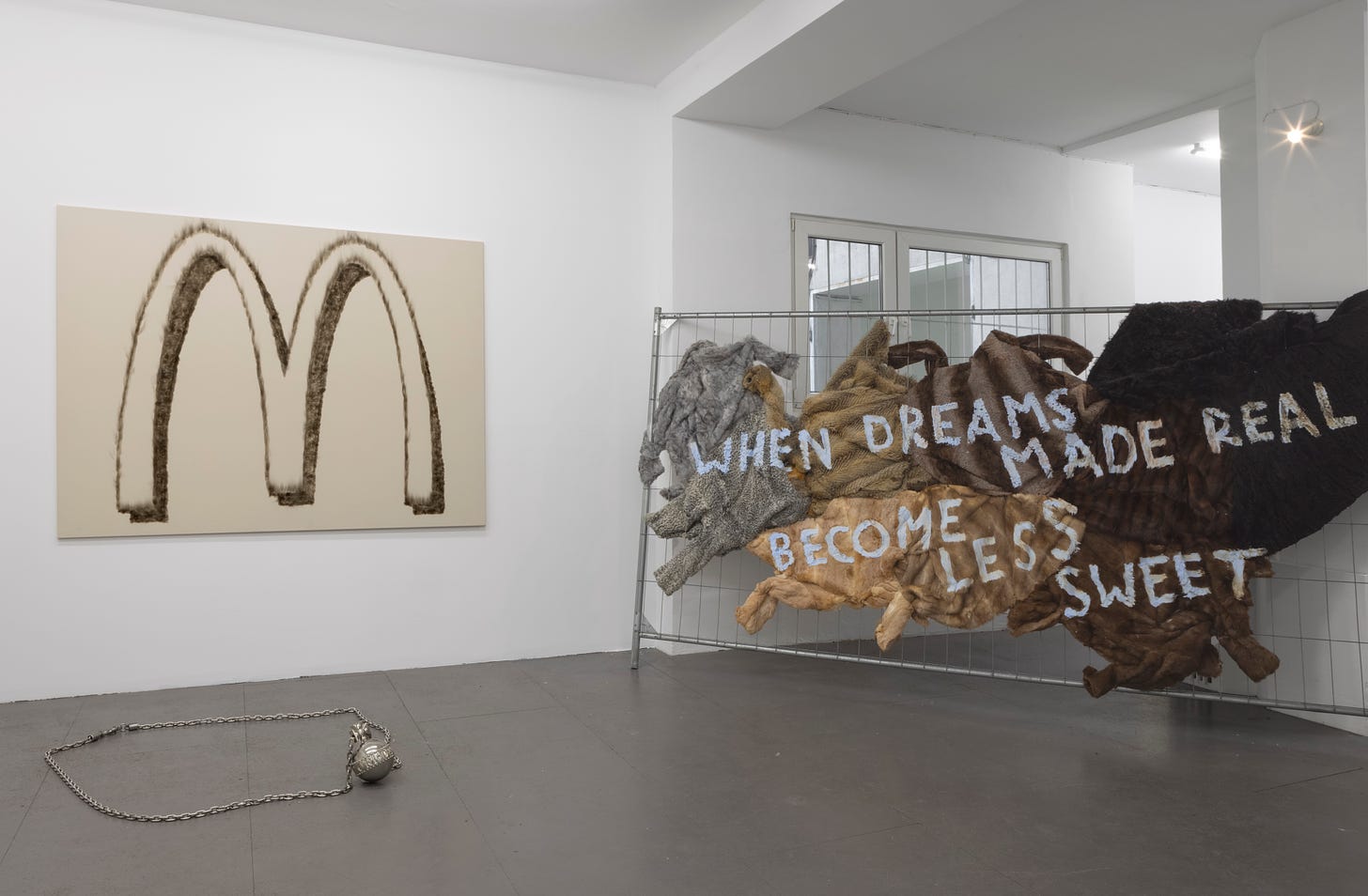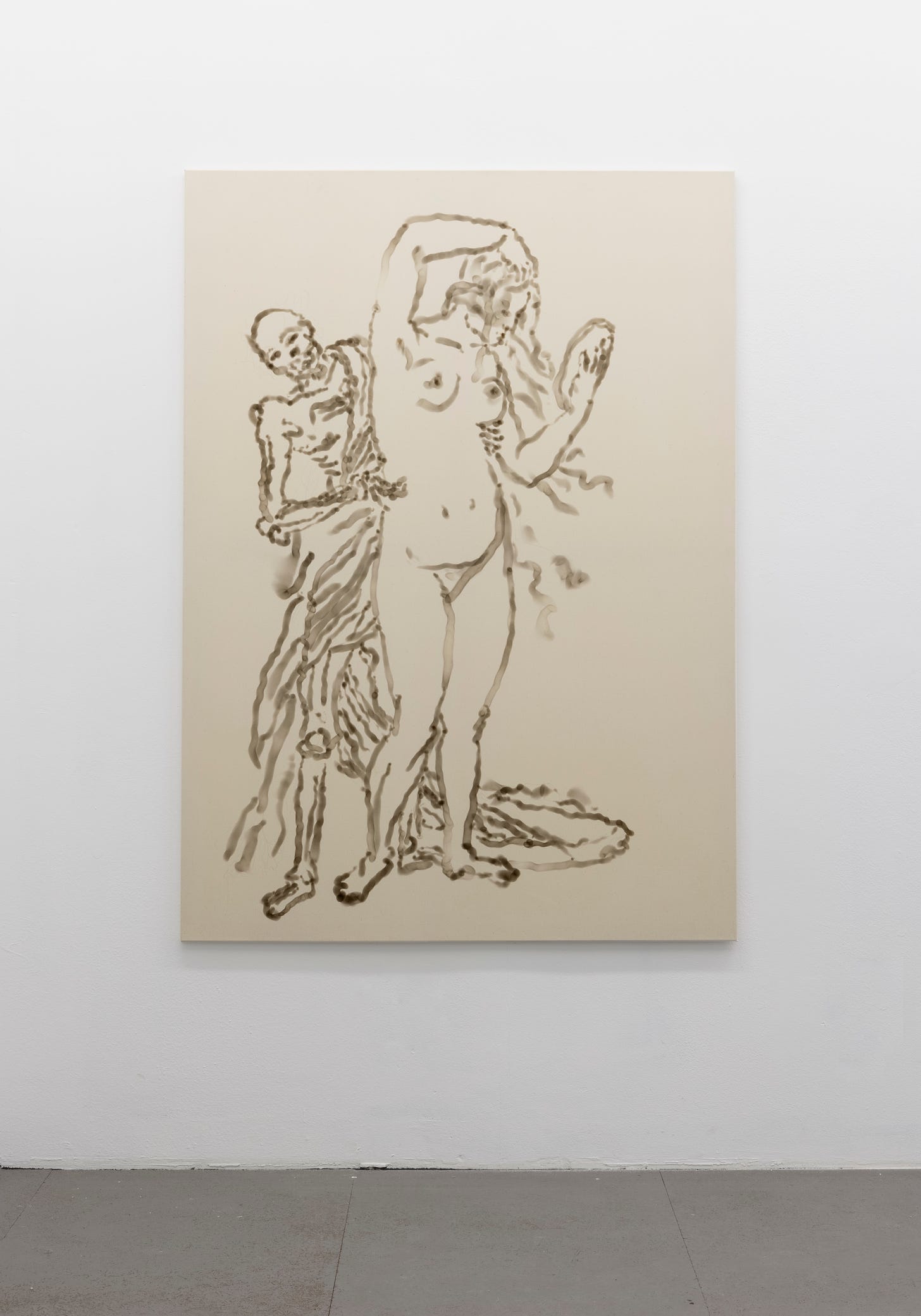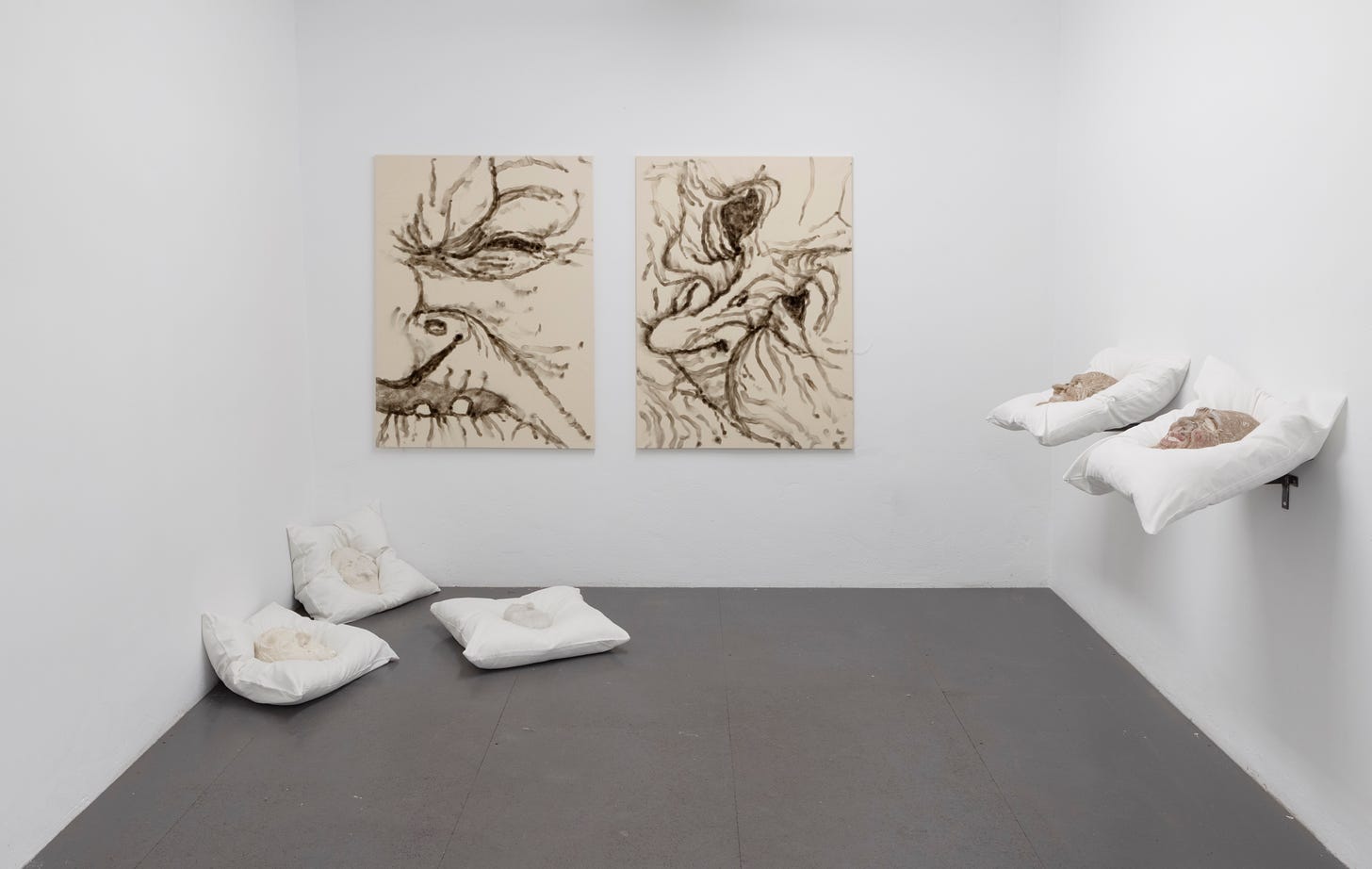Burn, Baby, Burn: Rebekka Benzenberg sets canvas on fire at MARTINETZ
I’ve been fangirling over Rebekka’s (Millennial, German) art since ART DÜSSELDORF last year. Reading in between the lines of her nonchalant energy, you get a lot to think about gender and class.
Furgalicious Definitions
Construction fences chop the gallery space into labyrinth-like sections. As if the attached jackets will add any warmth to those bare metal skelletons. But what you don’t know is that those jackets are not just velvet, they’re not suede, they’re not leather, they’re actually fur. And you’re also blithly unaware of the fact that as early as in the 11th century, fur was worn as a symbol of status and prestige. And then I think it was during the Renaissance… wasn’t it? that European nobility started to accessorize their robes with fur? And then fur quickly showed up as the exclusive indicator of class affiliation. And then it filtered down through the Bourgeoisie and Nouveau Riches and then in the ‘60s, it trickled on down into the wardrobes of movie stars and ordinary people and finally into some tragic casual corner where sex workers fished it out of some clearance bin. However, that fur represents millions of dollars and countless animals slaughtered and it’s sort of comical how you think that you’ve made a choice that exempts you from the fashion industry when, in fact, you’re playing along with the Mob Wife trend that was selected for you by the people in this room from a pile of stuff.
Rebekka started using fur long before it became a TikTok aesthetic. She used a fur jacket once and suddenly, she got them gifted left and right. Just the way that fur is both decadent and tacky (at least today), Rebekka plays with more connotations of high and low. Gwen Stefani lyrics adorn aluminum banners normally reserved for latin mottos or heraldic motives of aristocratic families. If you think about all that opulence of "Old Money”, “Quiet Luxury” has never been quiet at all.
A metallic imperial orb lies on the ground. Not quite the noble placement, innit? PULCHRIORI DETUR (2024) alludes to a 17th century poem praising Oxford University … That silver spoon must be stuck very deep... But even the worst trustfund kids go for Mcs after a night out...Those dividents on the McDonalds shares want to be spent. So is it really tacky if you make it a work of art? Look closely and you’ll see that Rebekka didn’t simply paint the iconic arched logo in I’m loving it (2024) but actually burnt it. She brings clubbing culture into the gallery, leaving messages with a lighter on walls and ceilings. She took the concept all the way, writing FOREVER YUMMY on the ceiling of the gallery bathroom. Girls just wanna have fun!
Art Historical Nudes
But wait, there’s even more jackets: Denim this time. Seven of them are sewn together with red patches reading the title-giving words BE STUPID (2024) in a Barbara Kruger (Baby Boomer, American) coded font smacked on them. This denimflation is so Justin & Britney. Another jacket combo with comically long sleeves has a black and white Venus patched on the backs. Mind you, it’s not any Venus, but the famous Rokeby Venus (1647-51) by Diego Velázquez (1599-1660, Spanish). Rebekka named the work Mary Richardson (2024) after the suffragette who slashed Diego’s painting in 1914, trying to destroy “the most beautiful woman in mythological history”. And people attacked it again in 2023, gaining attention for the climate catastrophe. Isn’t that strange? Why would the image of a woman be attacked for the consequences of misogyny instead of that of a man?
Rebekka observes and challenges these dynamics in her smoked canvases. I like the way she leaves the canvases blank and unprimed, like they’re naked in their own way. She chooses famous female bodies from art history as her motive, often in the nude (and certainly painted by men). These images of what women were supposed to look like burnt themselves into the imagination of one generation followed by another, just like that soot from the lighter staying on Rebekka’s stretched linen.
The Bitch-Beauty Spectrum
Carnivalesque masks lie on white squishy pillows. But not those sexy Fifty Shades of Grey masks that the cool girls wear for Halloween. No. These are wrinkly, unflattering faces of old women. Witch masks? I don’t know, you tell me. Is old woman = crusty wench on broom? I can’t deny that this is what came to my mind first. I think back to that Rokeby Venus and Rebekka’s reworked versions of death appearing as a skelleton snatching life away from a beauty like in Spiting evil’s dead (2024). Often, these young beautiful women are portrayed looking into a mirror, like in In the morning after the night, I fall in Love with the light (2024). Oh how the patriarchy loves to run its mouth: Vanity, it says. Be pretty, it says. But don’t realize that you are. And someday you’ll get old anyway, so all you have is your beauty right now. But don’t hold on to it.
Rebekka explores two themes in this exhibition: Womanhood in a world dictated by the male gaze and class affiliation. For millennia, beauty was women’s main capital and primary resource that kept them alive and secured a livelihood under the protection of a man. Historically, women experienced class dynamics much harsher than men did: Marry up, if you want to survive. But if you want to be cool, mingle with the bohème and do opium or whatever Henri de Toulouse-Lautrec (1864-1901, French) was on. Playing poor is always much more fun than being it. But the harsh truth is, if your name’s not on the list, no status symbol and no expensive fur coat will let you cross over to the party beyond those fences.
Watch it all burn to ashes at Rebekka Benzenberg: TAKE A CHANCE, until April 27, 2024, at MARTINETZ.
MARTINETZ
Moltkestrasse 81
50674 Cologne
Website
IG: @petramartinetz @rebekka.benzenberg
Rebekka ain’t no hollaback girl, but you probably already know by now. If you enjoy my reviews, I’d appreciate it so much if you supported my writing with a like, a comment, or a share.
See you soon!!!
Jennifer
The Gen Z Art Critic








